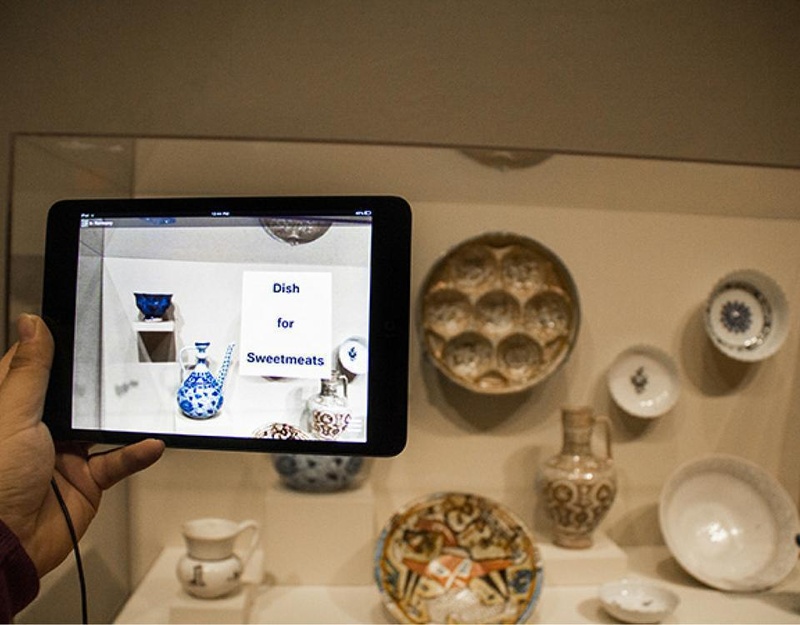Amidst the urbanity of Jamaica Plain, Harvard’s Arnold Arboretum—considered one of the University’s premier science museums—is a plant enthusiast’s haven. From conifers to crabapples, it is home to all manner of flora and fauna, both foreign and indigenous.
Sustaining these plants are many bees—but one in particular is of special interest to researchers. Latched to a wooden track, it is equipped with a UV camera linked to a classroom computer, enabling students to see the Arboretum through the eyes of one of its most important inhabitants.
The Arboretum’s experiment is one of the many examples of how technological innovation has found its way into Harvard’s museum spaces. Supported by the work of metaLAB (at) Harvard, a research center focused on bridging the humanities and technological innovation, Harvard’s museums, both indoor and out, are seeking to create a more digitally-enhanced viewer experience.
“Someone can still look into this meadow and see it’s beauty or its ugliness, but they can be armed with more knowledge,” says Kyle T. Parry, one of the project’s researchers. “There can be this compulsion to look closer.”
As the renovation of the Harvard Art Museums nears its completion this fall, the new space offers many opportunities for including technology.
“The role that digital initiatives will play in this museum will be much more present,” says Director of Harvard Art Museums Thomas W. Lentz. “We hope that people, when they walk in, will go, ‘Yes, this is the museum that I remember, but it’s so much better.’”
Museum innovators are not waiting until the new building opens to experiment. The opening of the Norma Jean Calderwood Collection of Islamic Art at Harvard’s Arthur M. Sackler Museum in January, for example, marks the first time Harvard Art Museums has used augmented reality technology.
For some, however, a traditional encounter with a work of art in a museum is necessarily devoid of a device like an iPad. And as Harvard’s cultural collections come of age in the digital era, curators and other museum administrators must straddle a fine line between enhancing their collections and distracting from their original purpose.
FOGG 2.0
With its main building under renovation, Harvard Art Museums is undergoing a makeover. The building—an empty giant on Quincy Street—is more pregnant with possibility than ever before.
The completion of the renovation, which was first conceived almost ten years ago and broke ground in 2010, has been delayed by almost a year due to structural problems and unexpectedly high levels of asbestos. But by the time the building is set to open in late 2014, Lentz says the museum should be “state-of-the-art.”
“This isn’t going to be simply a very expensive, static treasure house,” Lentz says. “We fully expect this museum to much more effectively and imaginatively serve all of Harvard.”
According to Lentz, the existing structure of the building is easily adaptable to new technological additions. Although museum administrators stressed that all plans for the new space are preliminary, there are many ideas for how to bring the galleries into the digital age.
One project currently under consideration, for example, is a digital “screen-wall” on which visitors to the museum could use gesture-based navigation—harnessing body movements rather than touch to trigger the screen—to explore digital resources, according to Jessica L. Martinez ’95, Director of Academic and Public Programs.
Additionally, the new museum will feature three 1000-square foot “curricular galleries” to be used for teaching. By coupling exhibit and classroom space, the museum will become a tool for classes that may be better suited to an object-based syllabus than a text-based one.
Read more in News
Student Organizations Stage Same-Sex Hindu WeddingRecommended Articles
-
Arboretum Adds FacilityAs the first days of spring bring warm weather and blossoming flowers to the Cambridge area once again, plant scientists at the Arnold Arboretum have a lot to celebrate.
-
 Arboretum Curator’s Art Takes Root
Arboretum Curator’s Art Takes Root -
Arboretum Employees Sign Petition in Support of HUCTWA group of sixteen members of the Service Employees International Union Local 615 voiced support for the Harvard Union of Clerical and Technical Workers’ position in its contract negotiations in a letter sent to University President Drew G. Faust and Deputy Director of Labor Relations Susannah P. Scannell last Thursday.
-
 Engagement: Anthony J. Staccone ’13 and Anika R. Petach ’13
Engagement: Anthony J. Staccone ’13 and Anika R. Petach ’13 -
 Get Out: Arnold Arboretum
Get Out: Arnold Arboretum -
 Rebuilding the Past: Harvard's Beautification Renaissance
Rebuilding the Past: Harvard's Beautification Renaissance














